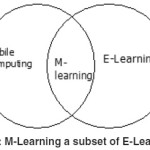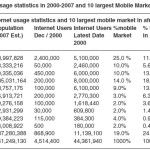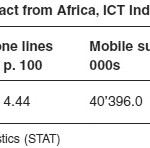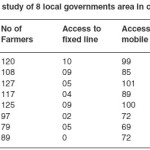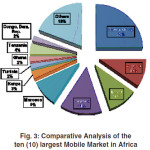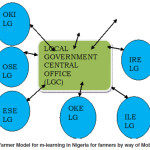Toward a Model of M-Learning for Enhancing Dissemination of Information Among Nigerian Farmers
Introduction
E-learning offers new methods for education based on computer internet technology. M-learning is the intersection of mobile computing and e-learning (Quinn, 2000); M-learning has the ability to learn everywhere at every time without permanent physical connection to cable networks. In Nigeria, farmers in the rural areas do not have access to information that will improve their farming methods because of lack of communication between the government personnel and the farmers, but because of the new wave of technology, mobile devices are now affordable and available to the farmers in Nigeria, Information dissemination is now enhanced.
Mobile and Wireless technologies are being used in diverse areas such as travel, education, stock trading, military, package delivery, disaster recovery, and medical emergency care; but emphasis in this paper will be on mobile learning.
Mobile and wireless systems cover two areas mobility and computing. Mobile computing means continuous accessibility to the user while wireless implies communicating without wires. As indicated in (Agrawal, 1999) mobile and wireless technology has improved substantially, making mobile devices remarkably convenient and affordable and M-Learning a reality.
What is M-Learning?
Mobile learning is effectively a sub-category of the larger concept of e-Learning. According to Clark Quinn mobile learning is “the intersection of mobile computing and e-learning: accessible resources wherever you are, strong search capabilities, rich interaction, powerful support for effective learning, and performance based assessment – e-learning independent of location in time and space”(Quinn, 2001) So we can define M-learning as the intersection of Mobile Computing and e- learning as shown in figure 1. M-learning is also the combination of mobile technologies and appropriate pedagogy to allow learners to interact with learning environments, and other learners, at any time from any location.
Why M-Learning?
According to (Brown, 2003) M-learning is a natural extension of e-learning. It has the potential to further expand where, how, and when we learn and perform in all aspects of our life. A key benefit of M-learning is its potential for increasing productivity by making learning available anywhere and anytime, allowing learners to participate in educational activities without restriction of time and place. Mobile technologies have the power to make learning even more available and accessible than we are used to in existing e-learning environments. M-learning can also give just- in- time information where Nigeria farmers can actually access information at the place and time that they need it. M-learning can be information seeking, content delivery, adhoc questions and answers, notes, comments between government personnel and farmers (Cherry, 2003) The development and adoption rate of mobile technologies are increasing rapidly on a global scale; there are numerous applications for mobile technologies in agriculture from the ability to wirelessly transmit information modules and farmers’ data, to farmers and other peers “on-the-go” (Kossen, 2001).
Mobile Devices
Mobile learning is impossible without the use of the mobile devices. They vary significantly in their abilities, sizes and prices (CeBIT 2004). The common ability which united them is their mobility and possibility to make wireless connections. The main types of mobile devices used in the education process are:
Notebook Computers
From one hand they have such abilities as desktop personal computer; from the other hand they have small sizes and support wireless communications. Their prices are still high.
Tablet PC
These are one of the newest mobile devices. They also have full range of abilities as personal computers. Some of them haven’t keyboard but have software to recognize handwritten text. It is relatively expensive.
Personal Digital Assistant (PDA)
They have small sizes and significant processor power. New models support more than 65000 colors, recognize handwritten text and can play different types of multimedia files. The main operating systems used are Palm and Microsoft Pocket PC.
Cellular Phones
The low class devices mainly can be used for voice communication and sending and receiving of text messages (SMS). Some of their disadvantages are low memory capacity and low data transfer rate. The cellular phones from the higher class can be used to Internet access via WAP or GPRS technologies. They also can be used to send and receive the multimedia messages (MMS). Their prices continuously decrease.
Smart Phones
They are hybrid devices which combine the abilities of cellular phones and PDA. They have smaller sizes than PDA and bigger than cellular phones. Typically they haven’t full sized keyboard and can recognize handwritten text. They use Symbian, Windows Mobile or other operating system. As they have Internet browsers they have potentiality to be successfully used in the mobile multimedia education. Today there are several communication technologies which are used in mobile devices. Their abilities vary vastly as well as data transmission range and range(CeBIT 2004)
Mobile and Wireless Technologies
Global System For Mobile Communications (GSM)
Is one of the leading digital cellular systems. It uses narrow band TDMA (Time Division
Multiple Access). Originally a European standard for digital mobile telephony, GSM has become the world’s most widely used mobile system in use in over 100 countries. GSM networks operate on the 900 MHz and 1800 MHz waveband in Europe, Asia and Australia, and on the MHz 1900 waveband in
North America and in parts of Latin American and Africa. It provides integrated voice mail, high – speed data, fax, paging and short message services capabilities, as well as secure communications. It offers the best voice quality of any current digital wireless standard.
Wireless Application Protocol (WAP)
This is a free, unlicensed protocol for wireless communications. It makes possible creation of advanced communications services and access to Internet pages from a cellular phone. WAP devices understand the WML language (an XML application) that is optimized for small screens and navigation without a keyboard. WAP also supports WML script scripting language.
General Packet Radio Service (GPRS)
A packet linked technology that enables high speed wireless internet and other data communications. GPRS provides about four times greater speed than conventional GSM systems. Currently 288 operators around the world have commercial GPRS services.
Bluetooth
Wireless technology is a short range radio technology. Bluetooth makes it possible to transmit signals over short distances between telephones, computers and other devices and thereby simplify communication and synchronization between devices.
IEE 802
11 is a type of radio technology used for wireless local area networks (WLANs). It is a standard that has been developed by IEEE (Institute of Electrical and Electronic Engineers). Wi-Fi (802.11) is composed of several standards operating in different radio frequencies: 802.11b is a standard for wireless LANs operating in the 2.4 GHz spectrum with a bandwidth of 11 Mbps; 802.11a is a different standard for wireless LANs, and pertains to systems operating in the 5 GHz frequency range with a bandwidth of 54 Mbps. Another standard, 802.11.g, is for WLANS operating in the 2.4 GHz frequency but with a bandwidth of 54 Mbps.
Infrared Data Association (IrDA)
This association defined a suite of protocols for infrared (IR) exchange of data between two devices, up to 1 or 2 meters apart (20 to 30cm for low – power devices). IrDA devices typically have throughput of up to 115.2Kbps or 4Mbps. Smart phones, many PDAs, printers and laptop computers use IrDA protocols.
Nigeria – Convergence, Broadband and Internet Market Report
According to Internet Usage and Marketing Report (2008), Nigeria’s Internet sector has been hindered by the country’s underdeveloped and unreliable fixed-line infrastructure, but this is changing as competition intensifies and new technologies are able to deliver wireless broadband access. More than 400 ISPs have been licensed as well as a number of data carriers, Internet exchange and gateway operators. Voice over Internet Protocol (VoIP) is already carrying the bulk of Nigeria’s international voice traffic. The current deployment of the country’s first Next Generation Networks (NGN) will drive further convergence of voice, data and video/TV, enabling the provision of triple-play services that will ultimately also involve the country’s already competitive broadcasting sector (Internet Usage and Marketing Report 2008). (Hamadoun, 2006) reported that African firms and telecommunications operators are forging ahead with new services and advanced technologies.
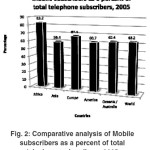 |
Figure 2: Comparative analysis of Mobile subscribers as a percent of total telephone subscribers, 2005
Click here to View figure
|
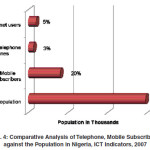 |
Figure 4: Comparative Analysis of Telephone, Mobile Subscribers against the Population in Nigeria, ICT Indicators, 2007
Click here to View figure
|
Going by what we have in table 4, it remarkable the spread of mobile telephony throughout the continent. Presently, Africa’s mobile usage has a growth rate of about 904% from 2000 to 2008; and that has made continent the fastest growing region in terms of mobile usage. Africa took over a hundred years to accumulate 28 million fixed lines: this is an average penetration rate of just 3 lines per 100 inhabitants, and is still below 1 line per 100 inhabitants in many countries. The stunning growth of mobile telephones, led mainly by private operators, means that mobile phones overtook fixed lines in 2001 and now outnumber fixed lines by nearly five to one, with 2 million mobile subscribers in 2005 (Hamadoun, 2006).In table 3 as graphically represented in figure 4, the percentage of mobile market as at 2005 is 14.0% with the Internet usage growth of 3,900% from 2000-2007. According to figure 5, we discovered that 25% of all cellular mobile subscribers live in South Africa, 14% live in Nigeria, while the four Maghreb countries (Algeria, Egypt, Morocco, and Tunisia) account for a further 10%, 10%, 9% and 2% respectively of all African mobile subscribers. All the remaining African economies altogether account for just about 30% of subscribers.
Nigeria Mobile Market – Overview and Statistics
According to (ITU:2007a, 2007b, 2008),the transformation of Nigeria’s telecommunications landscape since the licensing of three GSM networks in 2001 and a fourth one in 2002 has been nothing short of astounding. With triple-digit growth rates for five years in a row, it passed Egypt and Morocco in 2004 to become the continent’s second largest mobile market after South Africa and is set to take the top position during 2007, even though the growth curve has now started to flatten. And yet it has only reached about one third of its estimated ultimate market potential. The licensing of a fifth GSM network and four 3G networks in early 2007 will give additional impetus to the market, as will the new unified licensing regime introduced in 2006, designed to increase competition between fixed and mobile network operators.
Then one may want to ask, how well connected is Nigeria? According to table 3 and figure 6 below, the data for 2007 show that 5% of Nigeria’s 148,090,000 inhabitants (nearly 16 per cent of Africa’s population) had access to the
Internet, 3% have access to main telephone lines, while 20% are mobile subscribers.
Why M-Learning for Nigerian Farmers
Most farmers in Nigeria now have access to mobile phone see table 3. The strength of M-Learning lies in a communication approach rather than a content approach. This statement by no means implies that M-learning cannot have a content approach. Mobile technologies and mobile devices will in the future, be used with the content approach, but the real advantages of M-learning lies in the communication domain. Why then all the fuss about M-learning if it is merely a subset of e-learning?
M-learning provides more mobility, flexibility and convenience than online learning. Life-long learning demands learning while you earn which is possible through e-learning. M-Learning takes it further and makes it possible to learn while you earn on-the-go.
Mobile technologies such as mobile phones allow for synchronous audio communication with much greater ease and at a relative lower cost than online technologies, especially in areas where bandwidth is still a limitation as in Nigeria.
Why M-learning in Nigeria?
Well the answer is quite interesting. Because of lack of infrastructure for ICT (Cabling for internet and telecom) in Nigeria, the growth of wireless infrastructure is enormous. (Shapshak, 2001) Reported that the adoption rate of mobile technologies in Africa’s developing countries is among the highest rate globally and forecasts estimate almost 200 million mobile users in Africa by 2007.
A Model for M-Learning in Nigeria for Farmers by Way of Mobile Phone- 2008
A Case Study of 8 Local Governments Area in Ondo State Nigeria
This Farmer model shown above is designed for use in 8 local governments of Ondo state, Nigeria.
Components of the farmer model includes
Server Module located at the local government central office (LGC) will include the server, the agricultural strategies unit and a database: The LGC server manages the network resources.
Wireless Technology is in the form of Bluetooth and Wi-Fi
Mobile phones
Farmers from eight local governments
Farmers have periodic access to the server located at the local government central office using their mobile phones, hence enabling them to have access to agricultural information needed through SMS.
Conclusion
Variety of mobile devices are available today; smart phones, PDAs and tablet PCs are the most applicable mobile devices for delivering Information. PDAs offer greater functionality than mobile phones and similar advantages to tablet PCs, though tablet PCs are more robust than PDAs and offer additional features. PDAs, Tablet PCs, and mobile phones can be used in many educational settings and accomplish many different educational tasks. These mobile devices are useful in dissemination of information, education both as administration, organization and teaching aids for practitioners, and also as learning support tools for students. M-learning fulfills the growing demands for life-long learning opportunities that enable learners to “learn while you are on the go” Mobile phones play the most prominent role in Nigeria. Nigeria is actually leaping forward from an unwired, nonexistent e-learning infrastructure to a wireless e-learning infrastructure. The statistics in this regard are already significant proof of this process. Our model of M-learning in figure 5 will surely improve farming in Nigeria.
The role of m-learning in the future of Nigeria should not be underestimated. M-learning in Nigeria is a reality that will continue to grow in form, stature and importance.
References
- T.H. Brown, The Role of M-learning in the future of E-learning in Africa 2003 Fromhttp:/ /www.html.hut.fi/Opinnot/T-110.556/2004/ Material/brown03.pdf
- CeBIT 2004 – Catch a glimpse of the future, http://www.siemens-mobile.com.
- S. Cherry, Tthe Wireless Last Mile. IEEE Spectrum, September, 2003
- J.S. Kossen, when e-learning becomes m-learning. E-learning, 2001(6), Mobile E-learning section. From http:// www.palmpowerenterprise.com/issues/ issue200106/elearning001.pdf
- C. Quinn, M-Learning: mobile, wireless, In-Your-Pocket Learning 2000 http://www. linezine.com/2.1/features/cqmmwiyp.htm
- Agrawal, D.P. Future directions in mobile computing and networking systems. Workshop sponsored by the NSF, University of Cincinnate (June 13-14). 1999; www.ececs.uc.edu/_dpa
- Bluetooth; www.bluetooth.com.
- Estrin, D. et al. Next Century Challenges: Scalable Coordination in Sensor Networks. ACM Mobicom, 1999.
- Hamadoun I. Touré Competitiveness and Information and Communication Technologies (ICTs) in Africa International Telecommunication Union 2006. www.weforum.org/pdf/gcr/africa/1.5.pdf
- GPS application; ares.redsword.com/gps.
- Internet Usage and Marketing Report, World Internet Users and Population Stats, Internet usage statistics – The Big Picture. Retrieved 8th May 2008 from: http://www.internetworldstats.com/stats.htm (2008).
- ITU. African Telecommunication/ICT Indicators: At a crossroads 8th ed 2008 http:/ /www.itu.int/ITU-D/ict/publications/africa/ 2008/index.html (2008).
- ITU-D. Africa, ICT Indicators, 2007, Market Information and Statistics (STAT) http://www.itu.int/ITU-D/ict/statistics/at_glance/ af_ictindicators_2007.html (2007).
- ITU,Nigeria_-_Mobile_Market _-_Overview_and_Statistics http:// www.budde.com.au/buddereports/2998/Nigeria_-_Mobile_Market_- _Overview_and_Statistics.aspx?r=51 (2007).
- Kahn, J.M., et al. Next Century Challenges: Mobile Networking for Smart Dust. ACM Mobicom, (1999).
- Manjestwar, A. Energy Efficient routing protocols with comprehensive information retrieval for wireless Sensor networks. M.S. Thesis, University of Cincinnati, OH, May 2000.
- The Ultra Low Power Wireless Sensors project; www-mtl.mit.edu
- Shapshak,D. Unwiring Africa. DigAfrica 2001 from http://groups.yahoo.com/group/ DigAfrica.

This work is licensed under a Creative Commons Attribution 4.0 International License.
